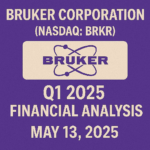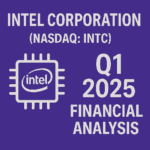SoundHound AI, Inc. (NASDAQ: SOUN)
Q1 2025 Financial Analysis | May 8, 2025
Executive Summary
SoundHound AI reported an exceptional first quarter 2025 with revenue increasing 151% year-over-year to $29.1 million, reflecting strong momentum across its voice AI solutions. The company achieved GAAP net income of $129.9 million, primarily driven by a favorable non-cash adjustment related to acquisition liabilities. On a non-GAAP basis, which excludes this impact, the company reported a net loss of $(22.3) million. SoundHound maintained a strong balance sheet with $246 million in cash and no debt as it continues to expand its customer base across industries and develop new applications for its voice AI technology.
Q1 2025 Highlights
Financial Performance
SoundHound AI delivered exceptional revenue growth of 151% in Q1 2025, with revenue reaching $29.1 million compared to $11.6 million in Q1 2024. This strong performance reflects the company's successful expansion across multiple industry verticals and the growing demand for its voice AI solutions. Notably, no single customer accounted for more than 10% of total revenue, highlighting the company's successful diversification strategy.
While GAAP gross profit increased by 53% to $10.6 million, GAAP gross margin declined from 59.7% to 36.5% year-over-year. This margin compression primarily reflects the impact of scaling new customer implementations and integration costs related to recent acquisitions. On a non-GAAP basis, which excludes amortization of intangible assets and stock-based compensation, gross margin was 50.8%, compared to 65.5% in the prior year period.
The company reported GAAP operating income of $128.1 million, a significant improvement from the operating loss of $(28.5) million in Q1 2024. However, this improvement was primarily driven by a $176.1 million non-cash gain from the mark-to-market adjustment of contingent acquisition liabilities, reflecting the decrease in the company's stock price during the quarter. Excluding this non-operating impact, non-GAAP adjusted EBITDA was $(22.2) million, compared to $(15.4) million in Q1 2024.
GAAP net income was $129.9 million, or $0.31 per diluted share, compared to a net loss of $(33.0) million, or $(0.12) per share, in the first quarter of 2024. On a non-GAAP basis, which provides a clearer view of the company's underlying operational performance, net loss was $(22.3) million, or $(0.06) per share, slightly higher than the non-GAAP net loss of $(20.2) million, or $(0.07) per share, in the prior year period.
Operating expenses increased year-over-year, primarily due to higher investment in research and development, which grew to $24.8 million from $14.9 million in Q1 2024, reflecting the company's continued focus on innovation and expanding its technological capabilities. Sales and marketing expenses more than doubled to $12.0 million from $5.5 million as the company enhanced its go-to-market strategy to capitalize on growing market opportunities.
Business Segment Performance
While SoundHound does not report detailed revenue breakdowns by business segment, the company highlighted strong performance across multiple industries. Key business verticals showing significant growth and momentum include:
Restaurants: SoundHound expanded its presence in the restaurant industry, extending partnerships with one of the largest pizza chains in the US and adding locations with established brands such as Habit Burger, Casey's, Firehouse Subs, Five Guys, White Castle, and McAlister's. The company's voice AI solutions for phone answering and ordering continue to gain traction in this sector, demonstrating the value proposition of automating customer interactions while improving service quality.
Automotive: The company strengthened its position in the automotive sector through a new partnership with Tencent Intelligent Mobility to bring conversational AI to Intelligent Cockpits for global auto brands. SoundHound also expanded its relationship with NVIDIA, showcasing its voice assistant leveraging generative AI at NVIDIA GTC 2025. The automotive sector remains a key growth driver as vehicle manufacturers increasingly integrate voice-enabled technology into their products.
Healthcare: SoundHound renewed or expanded contracts with three healthcare customers, including a prominent medical billing company and healthcare providers. Three new healthcare deals secured in Q4 2024 are now live, demonstrating the company's ability to rapidly implement its solutions and deliver value in this regulated industry.
Financial Services: The company continued to gain traction with major financial institutions, securing significant renewals with four financial institutions and signing one of the world's largest insurance companies in Europe. The financial services sector represents a substantial growth opportunity as organizations seek to enhance customer service efficiency and reduce operational costs.
Other emerging sectors showing promising growth include Retail, Energy, Information Technology, Telecom, and Travel & Hospitality. The company signed strategic pilots with multiple top U.S. fitness chains and leading home services franchises, launched an AI Agent for a large utilities company, and secured a deal with the leading luxury resort developer in Latin America.
Strategic Initiatives
SoundHound's strategic initiatives in the first quarter focused on expanding its technological capabilities and enhancing its go-to-market strategy:
Key Strategic Developments
- Agentic AI Expansion: Unveiled Amelia 7.0, allowing businesses to harness the power of full Agentic AI with category-leading voice technology. The platform represents a significant advancement in SoundHound's capabilities, with smart AI agents that can reason and perform complex tasks with humanlike interactions.
- Voice Commerce Innovation: Integrated dozens of restaurant brands into its voice commerce solution and initiated pilots with multiple automakers, including the innovation team at one of the world's largest automotive brands. This cross-industry application demonstrates the versatility of SoundHound's technology.
- Strategic Partnerships: Established partnership with Pindrop to bring powerful security and authentication tools to voice-powered AI agents, addressing a critical need for secure voice authentication in sensitive applications. Also partnered with PowerConnect.AI to expand into the utilities sector.
- Channel Partner Expansion: Successfully worked with channel partners to win new customers, including a large global agriculture OEM, a global tax preparation company, and a North American travel and hospitality company. The company also expanded with a large systems integrator and renewed its relationship with a Japanese multinational IT corporation.
- Product Portfolio Enhancement: Unveiled a next-generation AI platform for restaurants, enhancing the Dynamic Drive-Thru solution with omnichannel ordering capabilities. SoundHound Chat AI Automotive introduced new Brand Personalities features, further differentiating the company's offering in the automotive sector.
These strategic initiatives position SoundHound to capitalize on the growing demand for voice AI solutions across industries. The company's focus on enhancing its core technology platform while expanding its market reach through strategic partnerships and channel relationships provides a solid foundation for continued growth. SoundHound's recognition as an "exemplary" market leader for AIOps by ISG Research further validates its technological leadership in the voice AI space.
The company's expanding product portfolio, which now includes comprehensive solutions for industries ranging from restaurants and automotive to healthcare and financial services, enables it to address a broader set of customer needs and capture a larger share of the growing voice AI market. By focusing on industry-specific applications of its technology, SoundHound is able to deliver more targeted value propositions that resonate with customers in these sectors.
Cash Flow and Balance Sheet
SoundHound maintained a strong financial position at the end of Q1 2025:
- Cash Position: $246 million in cash and cash equivalents as of March 31, 2025, up from $199 million at the end of 2024, providing substantial runway to fund growth initiatives and investments in technology
- Debt-Free Balance Sheet: The company operates with no debt, providing financial flexibility and reducing interest expense
- Operating Cash Flow: Net cash used in operating activities improved to $(19.2) million in Q1 2025 from $(21.9) million in Q1 2024, reflecting the company's progress toward operational efficiency
- Financing Activities: Generated $67.0 million from financing activities, primarily from the sale of Class A common stock
- Total Assets: $587.5 million as of March 31, 2025, compared to $554.0 million at December 31, 2024
The company's accounts receivable decreased to $20.2 million from $23.2 million at the end of 2024, while contract assets and unbilled receivables decreased to $21.4 million from $26.6 million. This improvement in working capital management contributes to the company's overall financial stability.
Total liabilities decreased significantly to $190.5 million from $371.3 million, primarily due to the reduction in contingent acquisition liabilities, which decreased to $113.1 million from $286.9 million. This reduction reflects the mark-to-market adjustment of these liabilities based on the company's stock price at the end of the quarter.
Stockholders' equity more than doubled to $397.0 million from $182.7 million at the end of 2024, reflecting both the capital raised during the quarter and the positive net income for the period. This strengthened equity position provides a solid foundation for the company's future growth initiatives.
The company's minimal capital expenditures, totaling just $162,000 in Q1 2025, highlight its asset-light business model, which allows for efficient scaling of operations without significant investments in physical infrastructure. This approach enables SoundHound to maintain high operational leverage as revenue continues to grow.
Outlook
SoundHound AI reaffirmed its full-year 2025 revenue outlook:
- Revenue expected to be in the range of $157-$177 million for the full year 2025
- This outlook implies continued strong year-over-year growth in the remaining quarters of 2025
- The company did not provide specific guidance for adjusted EBITDA or bottom-line metrics
Management expressed confidence in the company's growth trajectory, citing its expanding addressable market and accelerating momentum across diverse industry verticals. The company's distinctive value proposition in conversational voice AI is resonating with customers, leading to tangible returns and outcome-based results for end users.
SoundHound's leadership highlighted the company's strategic position at the intersection of artificial intelligence and voice technology, enabling it to capitalize on the growing demand for AI-powered solutions across industries. The company's platform approach, combining voice AI with generative AI capabilities, positions it well to address evolving customer needs and market opportunities.
The company's expanding customer base, with no single customer accounting for more than 10% of revenue in Q1 2025, demonstrates its successful diversification strategy and reduces dependence on any single client or industry. This diversification provides a more stable foundation for long-term growth and mitigates customer concentration risk.
While the company did not provide detailed quarterly projections, the full-year outlook suggests continued revenue growth throughout 2025 as SoundHound scales its existing customer relationships and onboards new clients across its target industries. The company's robust pipeline of opportunities, combined with its expanding product portfolio, provides multiple avenues for growth in the coming quarters.
Risks & Opportunities
Opportunities
Risks
Conclusion
Strengths
- Exceptional revenue growth (151% YoY)
- Diverse customer base with no client exceeding 10% of revenue
- Strong cash position of $246 million with no debt
- Expanding technological capabilities with Agentic AI and generative AI
- Strategic partnerships enhancing market reach and product offerings
Areas for Improvement
- Declining gross margins reflecting integration and scaling costs
- Increasing operating expenses impacting profitability
- Growing non-GAAP net loss year-over-year
- Continued cash burn from operations
- Need to demonstrate operational leverage as scale increases
Summary
SoundHound AI delivered an impressive first quarter with revenue increasing 151% year-over-year to $29.1 million, demonstrating strong market demand for its voice AI solutions. While GAAP results showed significant improvement, primarily due to a non-cash gain from contingent acquisition liabilities, the company's underlying operational metrics reflected ongoing investments in growth and technology development.
The company's strategic initiatives, including the launch of Amelia 7.0 and expansion of its voice commerce solutions, position it well to capitalize on the growing adoption of AI-powered voice technology across industries. SoundHound's partnerships with industry leaders like NVIDIA, Tencent, and Pindrop enhance its market position and technological capabilities.
Despite margin pressure and increased operating expenses, SoundHound's strong cash position of $246 million provides substantial runway to fund its growth initiatives. The company's debt-free balance sheet and diversified customer base reduce financial risk and dependency on any single client or industry.
Looking ahead, SoundHound reaffirmed its full-year revenue outlook of $157-$177 million, reflecting confidence in its growth trajectory. The company's focus on expanding its addressable market and delivering tangible value to customers across diverse industries should support continued revenue growth. However, investors will be watching for improvements in operational efficiency and progress toward profitability as the company scales its business in the coming quarters.






